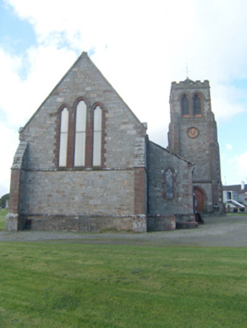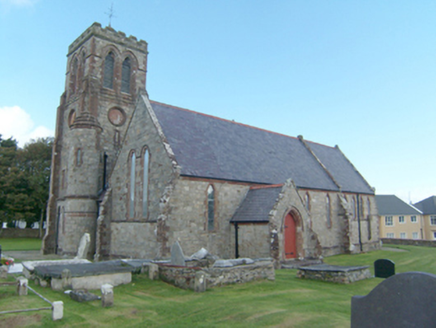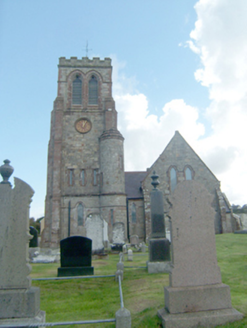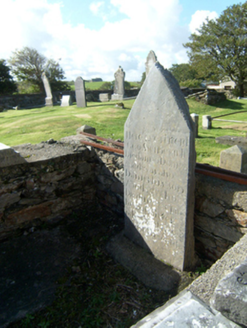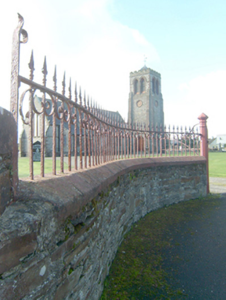Survey Data
Reg No
40808002
Rating
Regional
Categories of Special Interest
Architectural, Artistic, Social, Technical
Original Use
Church/chapel
In Use As
Church/chapel
Date
1890 - 1905
Coordinates
213223, 436670
Date Recorded
29/09/2010
Date Updated
--/--/--
Description
Detached double-height Church of Ireland church, built 1895-1902, having five-bay nave, two-bay chancel to the east end having two-bay single-storey sacristy attached to the north side, single-storey side aisle to the north, single-bay single-storey gable-fronted entrance porch to the south side of nave, and with four-stage tower (on square-plan) to the north-west having projecting cylindrical stair turret attached to the south-west corner. Pitched natural slate roofs with terracotta ridge tiles, moulded sandstone eaves course, cut sandstone verges to gable ends with decorative kneeler stones to eaves having gable-fronted finials over with inset trefoil motifs, and with cast-iron rainwater goods. Pyramidal natural slate roof to tower with metal finial over; conical cut sandstone roof over stair turret. Raised parapet to tower having cut stone crenellations over with ashlar coping, and with moulded stringcourse at base of parapet. Squared and snecked stone walls with flush dressed sandstone block-and-start quoins to corners, and with chamfered sandstone plinth course. Stepped ashlar sandstone clasping buttresses with feathered ashlar coping over to corners to nave gable (west) and nave (west) gable ends, to corners of tower, and to side elevations (north and south) at junction of nave and chancel, and with splayed stepped ashlar sandstone clasping buttresses with feathered ashlar coping over to corners of porch to the south elevation. Cut sandstone clock faces with moulded sandstone surrounds to each face of tower at third stage level. Moulded sandstone stringcourse to tower above first stage level. Pointed-arched window openings having chamfered ashlar sandstone block-and-start surrounds with cusped heads, chamfered ashlar sandstone sills, cut sandstone hoodmouldings, and with leaded coloured glass and stained glass windows. Three graded window openings to the chancel gable and two paired openings to the nave gable (west); some paired window openings to side aisle. Paired pointed-arch openings to tower at belfry level having chamfered staged ashlar sandstone block-and-start reveals with cusped head, continuous cut sandstone hoodmoulding brought around faces of tower as stringcourse, and with timber louvered fittings. Sill courses to the west and east elevations and to the south side of chancel. Some square-headed window openings to tower having ashlar sandstone block-and-start surrounds. Pointed-arched doorway to the east face of tower having chamfered ashlar sandstone block-and-start surrounds with staged head, cut sandstone hoodmoulding, and timber panelled double-doors. Pointed-arched doorway to the south face of porch to the south elevation having chamfered ashlar sandstone block-and-start surrounds with staged head, cut sandstone hoodmoulding, and with battened timber door wrought-iron strap hinges. Square-headed doorway to the north face of vestry having chamfered ashlar sandstone block-and-start surround and timber door. Stone steps to entrances. Set back from road in polygonal enclosure to the north-east end of Carrickart. Graveyard to south and west of site with collection of cut stone gravemarkers of mainly nineteenth and twentieth century markers of upstanding and recumbent types, some in metal railed enclosures. Family plot of the Clement family including graves of the Fourth (1892) and Fifth (1952) Earls of Leitrim of Mulroy House (see 40901712) to the west side of graveyard. Some eighteenth-century gravemarkers to site including memorial to former parish priest Revd. Dominick O'Donnell, buried 1793. Lawned areas to the north and to the north-east of church. Site surrounded by rubble stone boundary walls to ancillary elevations. Main gateway to the north-east of site comprising a pair of decorative cast-iron gate posts with decorative wrought-iron gates. Gateway flanked to either side by sections of curved rubble stone boundary wall having chamfered sandstone coping and wrought-iron railings over with cast-iron finials. Park adjacent to the west containing memorial cross (see 40808005) to the Fourth Earl of Leitrim.
Appraisal
This fine late nineteenth-century Church of Ireland church is a landmark feature on the streetscape to the north-east end of Carraig Art [Carrickart], and is one of the best examples of its type and date in Donegal. It was built in a robust Early English Gothic Revival style to designs by Sir Thomas Drew (1838-1910), a distinguished church architect who is probably best known for his designs for St. Anne's Cathedral (1898-1904), Belfast . Drew was responsible for restoration works at Raphoe Cathedral around the same time and may have been engaged by The Fourth Earl of Leitrim to extend nearly Mulroy House (40901712) sometime between c. 1880 and c. 1890. It is probable that some of the costs for the construction of this church were provided by the Fifth Earl\Clement family, possibly as a memorial for the Fourth Earl who is commemorated by the fine High Cross monument (see 40808005) adjacent to the west of the churchyard. This church at Carraig Art [Carrickart] is distinguished by the soaring robust tower to the north-west corner, a feature that dominates the design and the village of Carraig Art [Carrickart]. The exterior is enlivened by the high quality cut sandstone detailing, particularly to the openings and to the tower, which contrasts attractively with the grey dimension stone creating interesting tonal and textural variation that adds further to the appeal of this building. The three fine stained glass windows to the chancel gable (by Earley and Co. of Dublin) depicting the "Transfiguration" were installed in 1898. These were donated by a James Hay of Philadelphia, whose family were originally from Rosapenna near Carraig Art [Carrickart]. James Hay was a very successful businessman, president of several Philadelphia banks and a director of the Pennsylvanian Railway among other business interests. He was a frequent visitor to the area, and a number of members of the Hay family are buried in the graveyard at Carraig Art [Carrickart]. The bell tower to the north-west, which was dedicated in 1902, and the clock faces to same were also apparently donated by James Hay. It is possible that he also donated some of the other costs associated with the construction of this fine church, which is above what is normal seen in rural Church of Ireland churches of its date in terms of scale and detailing. Another fine stained glass window to the nave (dated 1917) is dedicated in memory of Rebecca Wilson of Magherabeg; this is by Ward and Partners of Belfast and depicts the "Empty Tomb". This fine church replaced an earlier church (see RMP DG017-021----) built in 1675, which was located adjacent to the south of the present edifice (Ordnance Survey first edition six-inch map of c. 1836). This church was described by Lewis in 1837 as '... in good repair; it was built about 160 years since'. To the interior of the present church is a fine seventeenth-century marble font (RMP DG017-021001-) with a quartered coat-of-arms and the inscription "EX: DONO R:A 1681". The church is surrounded by graveyard, which contains an interesting collection of upstanding and recumbent gravestones of mainly nineteenth- and twentieth-century date, some of which are finely carved and of artistic merit. There are a number of earlier gravemarkers dating to the eighteenth century and likely to be earlier possibly unmarked graves dating back to the foundation of the earlier church to site. A number of grave plots are set in wrought and\or cast-iron railed enclosures, adding additional interest. Also of interest is the family plot of the Clement family including graves of the Fourth (1892) and Fifth (1952) Earls of Leitrim of nearby Mulroy House (see 40901712). Apparently these Earls of Leitrim were buried here at their own wish instead of the family vault in Saint Michan's Church in Dublin. The simple rubble stone boundary walls, and the elegant gateway with cast-iron gate posts and wrought-iron gates, and the walls flanking the gateway with metal railings and cut stone coping over complete the setting of this church, which is an integral element of the architectural heritage and social history of the local area.


